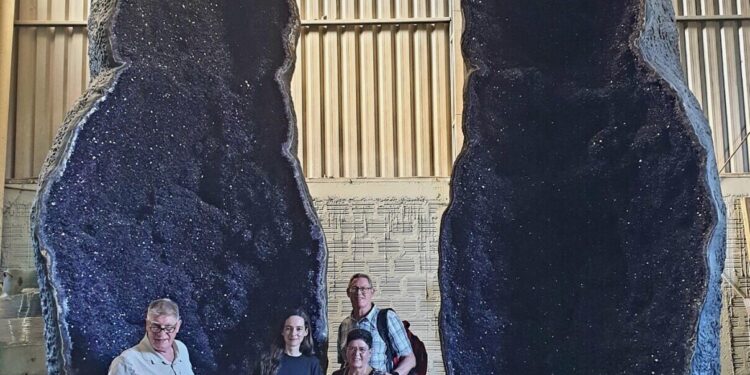Researchers from the University of Göttingen in front of a giant amethyst geode in Uruguay. Geodes like this have been found in cooled lava flows dating back to the initial breakup of the supercontinent Gondwana around 134 million years ago. From left to right: Dr Klaus Wemmer, Fiorella Arduin Rode, Dr Graciela Sosa, Dr Alfons van den Kerkhof. Credit: Fiorella Arduin Rode
Amethyst is a purple variety of quartz that has been used as a gemstone for many centuries and is a key economic resource in northern Uruguay. Geodes are hollow rock formations often containing quartz crystals, such as amethyst, inside.
Amethyst geodes in Uruguay have been found in cooled lava flows, which date to the initial breakup of the supercontinent Gondwana around 134 million years ago. However, their formation remains a mystery. A research team led by the University of Göttingen carried out research using cutting-edge techniques. The researchers found that amethyst geodes formed at surprisingly low crystallization temperatures, just 15 to 60°C.
Building on their other results, the researchers were able to propose a new model to explain their formation. The research is published in the journal Mineralium deposit.
Amethyst has been mined for over 150 years in the Los Catalanes district of Uruguay, where the research was conducted. It is a region renowned for the deep purple color and high quality of its gems, as well as its magnificent giant geodes, sometimes reaching over 5m in height. The deposits here have been recognized as one of the world’s top 100 geological heritage sites, highlighting their scientific and natural value.
Fiorella Arduin Rode, researcher at the University of Göttingen, works in an open-cast mine in the study area, Los Catalanes mining district, northern Uruguay. Along with Ametista do Sul in southern Brazil, these regions are the world’s leading mining districts for gemstones from volcanic lava, such as amethyst and agate geodes. Credit: Santiago Guerrero Cherma
However, limited knowledge of how these geodes formed has made locating them difficult, depending largely on the experience of miners. To address this issue, researchers conducted extensive geological studies at more than 30 active mines, analyzing geode minerals, geode-hosted water, and groundwater. Using advanced techniques such as single-phase initial fluid inclusion nucleation-assisted microthermometry and triple oxygen isotope geochemistry, the team discovered new insights into the formation of these prized geodes.
In addition to finding that amethyst geodes formed at surprisingly low crystallization temperatures, the researchers also showed that the mineralizing fluids had low salinity levels and an isotope ratio consistent with water from the cycle. natural climate, which probably came from groundwater contained in nearby rocks.
“The precision and accuracy of these new techniques allowed us to confidently estimate the temperature and composition of mineralizing fluids,” said lead author and doctoral student Fiorella Arduin Rode. researcher at the Center for Geosciences at the University of Göttingen. “Our results support the idea that these amethysts crystallized at low temperatures from groundwater-like fluids.”
Amethyst-calcite geode from Los Catalanes already worked in the workshop and ready to sell. Credit: Fiorella Arduin Rode
The study proposes a model in which mineral phases like amethyst crystallize in volcanic cavities in a dark rock called basalt, influenced by regional temperature variations in the Earth’s crust.
Arduin Rode adds: “Understanding the conditions of amethyst formation, such as the temperature and composition of the mineralizing fluid, as well as the source of silica, the timing of mineralization and its relationship to the host rocks, is crucial to unraveling the process. . This could significantly improve exploration techniques and lead to sustainable mining strategies in the future. »
More information:
Fiorella Arduin-Rode et al, World-class amethyst agate geodes from Los Catalanes, northern Uruguay: genetic implications of fluid inclusions and stable isotopes, Mineralium deposit (2024). DOI: 10.1007/s00126-024-01310-2
Provided by the University of Göttingen
Quote: Geological studies shed light on the mystery of the formation of Uruguay amethyst geodes (October 3, 2024) retrieved October 3, 2024 from
This document is subject to copyright. Except for fair use for private study or research purposes, no part may be reproduced without written permission. The content is provided for informational purposes only.



